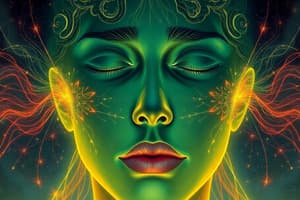Podcast
Questions and Answers
What type of coping involves managing emotional responses to a stressful situation?
What type of coping involves managing emotional responses to a stressful situation?
- Emotion-focused coping (correct)
- Avoidance coping
- Active coping
- Problem-focused coping
Which of the following factors is NOT mentioned as contributing to happiness?
Which of the following factors is NOT mentioned as contributing to happiness?
- Social relationships
- Genetics
- Financial stability (correct)
- Meaningful activities
The fundamental attribution error leads individuals to:
The fundamental attribution error leads individuals to:
- Misjudge the circumstances affecting others (correct)
- Underestimate personality traits in explaining behavior
- Overestimate situational influences on behavior
- Consider external factors before personal characteristics
Which method of persuasion focuses on presenting logical arguments to change attitudes?
Which method of persuasion focuses on presenting logical arguments to change attitudes?
What is a common misconception regarding the relationship between stress and health?
What is a common misconception regarding the relationship between stress and health?
What is the definition of altruism?
What is the definition of altruism?
Which factor is NOT typically associated with interpersonal attraction?
Which factor is NOT typically associated with interpersonal attraction?
Which of the following statements reflects a psychodynamic perspective on personality?
Which of the following statements reflects a psychodynamic perspective on personality?
What approach do humanistic theories emphasize in personality psychology?
What approach do humanistic theories emphasize in personality psychology?
Which of the following strategies is suggested for promoting peace from conflict?
Which of the following strategies is suggested for promoting peace from conflict?
What does the James-Lange theory suggest about the experience of emotion?
What does the James-Lange theory suggest about the experience of emotion?
Which division of the autonomic nervous system is responsible for the 'fight-or-flight' response?
Which division of the autonomic nervous system is responsible for the 'fight-or-flight' response?
What is the primary focus of psychotherapy?
What is the primary focus of psychotherapy?
Which of the following medications is primarily used to treat bipolar disorder?
Which of the following medications is primarily used to treat bipolar disorder?
What is a limitation of lie detection techniques, such as polygraphs?
What is a limitation of lie detection techniques, such as polygraphs?
In what way do women generally outperform men according to emotional expression studies?
In what way do women generally outperform men according to emotional expression studies?
What therapeutic approach emphasizes personal growth and self-actualization?
What therapeutic approach emphasizes personal growth and self-actualization?
What is a significant challenge in conducting research on psychotherapy?
What is a significant challenge in conducting research on psychotherapy?
What does the facial feedback effect propose regarding facial expressions?
What does the facial feedback effect propose regarding facial expressions?
What ethical responsibility is crucial for psychologists in therapy?
What ethical responsibility is crucial for psychologists in therapy?
What is a defining characteristic of psychological disorders?
What is a defining characteristic of psychological disorders?
Which of the following statements about the DSM-5 is true?
Which of the following statements about the DSM-5 is true?
What does the biopsychosocial approach suggest about psychological disorders?
What does the biopsychosocial approach suggest about psychological disorders?
What distinguishes bipolar I disorder from bipolar II disorder?
What distinguishes bipolar I disorder from bipolar II disorder?
Why is it important to consider cultural norms when diagnosing psychological disorders?
Why is it important to consider cultural norms when diagnosing psychological disorders?
What theory suggests that emotions are experienced through both physiological arousal and cognitive labeling of the arousal?
What theory suggests that emotions are experienced through both physiological arousal and cognitive labeling of the arousal?
Which individual is known for his pioneering research on the bystander effect?
Which individual is known for his pioneering research on the bystander effect?
Which psychologist is associated with the development of the General Adaptation Syndrome (GAS) model?
Which psychologist is associated with the development of the General Adaptation Syndrome (GAS) model?
What does the Cannon-Bard Theory suggest about emotional response?
What does the Cannon-Bard Theory suggest about emotional response?
What aspect of personality does the Five-Factor Model describe?
What aspect of personality does the Five-Factor Model describe?
Which theorist is best known for their psychoanalytic theory that emphasizes the influence of the unconscious mind?
Which theorist is best known for their psychoanalytic theory that emphasizes the influence of the unconscious mind?
Which therapy was specifically developed to treat borderline personality disorder?
Which therapy was specifically developed to treat borderline personality disorder?
Which response occurs during the alarm stage of the General Adaptation Syndrome (GAS)?
Which response occurs during the alarm stage of the General Adaptation Syndrome (GAS)?
What is a core concept of learned helplessness?
What is a core concept of learned helplessness?
What is the primary focus of positive psychology?
What is the primary focus of positive psychology?
What does the Fundamental Attribution Error illustrate about people's perceptions of behavior?
What does the Fundamental Attribution Error illustrate about people's perceptions of behavior?
What phenomenon occurs when individuals exert less effort in a group compared to when they work alone?
What phenomenon occurs when individuals exert less effort in a group compared to when they work alone?
Which of the following terms describes the tendency to favor one's own group over those who are perceived as different?
Which of the following terms describes the tendency to favor one's own group over those who are perceived as different?
Which strategy involves agreeing to a small request to increase the likelihood of agreeing to a larger request later?
Which strategy involves agreeing to a small request to increase the likelihood of agreeing to a larger request later?
What form of persuasion focuses on influencing others through incidental cues rather than logical arguments?
What form of persuasion focuses on influencing others through incidental cues rather than logical arguments?
Flashcards
Fundamental Attribution Error
Fundamental Attribution Error
Our tendency to overestimate the impact of personality traits and underestimate the impact of situations when explaining someone else's actions.
Stress and Illness
Stress and Illness
Prolonged stress can negatively affect physical and mental health, weakening the immune system and increasing the risk of chronic illnesses.
Conformity
Conformity
Adjusting one's behavior or thoughts to match group standards.
Prejudice
Prejudice
Signup and view all the flashcards
Persuasion (central route)
Persuasion (central route)
Signup and view all the flashcards
Emotion Components
Emotion Components
Signup and view all the flashcards
James-Lange Theory
James-Lange Theory
Signup and view all the flashcards
Cannon-Bard Theory
Cannon-Bard Theory
Signup and view all the flashcards
Lie Detection Challenges
Lie Detection Challenges
Signup and view all the flashcards
Emotional Expression
Emotional Expression
Signup and view all the flashcards
Prosocial Relations
Prosocial Relations
Signup and view all the flashcards
Interpersonal Attraction
Interpersonal Attraction
Signup and view all the flashcards
Personality
Personality
Signup and view all the flashcards
Psychodynamic Theories
Psychodynamic Theories
Signup and view all the flashcards
Trait Theories
Trait Theories
Signup and view all the flashcards
Psychological Disorder
Psychological Disorder
Signup and view all the flashcards
Biopsychosocial Approach
Biopsychosocial Approach
Signup and view all the flashcards
DSM-5
DSM-5
Signup and view all the flashcards
Anxiety Disorder
Anxiety Disorder
Signup and view all the flashcards
Depressive Disorders
Depressive Disorders
Signup and view all the flashcards
Therapy
Therapy
Signup and view all the flashcards
Psychotherapy
Psychotherapy
Signup and view all the flashcards
CBT
CBT
Signup and view all the flashcards
Biomedical Therapy
Biomedical Therapy
Signup and view all the flashcards
Ethical Considerations (Therapy)
Ethical Considerations (Therapy)
Signup and view all the flashcards
James-Lange Theory of Emotion
James-Lange Theory of Emotion
Signup and view all the flashcards
Schachter-Singer Two-Factor Theory
Schachter-Singer Two-Factor Theory
Signup and view all the flashcards
Stanford Prison Experiment
Stanford Prison Experiment
Signup and view all the flashcards
Cognitive Dissonance
Cognitive Dissonance
Signup and view all the flashcards
General Adaptation Syndrome (GAS)
General Adaptation Syndrome (GAS)
Signup and view all the flashcards
Attribution Theory
Attribution Theory
Signup and view all the flashcards
Peripheral Route Persuasion
Peripheral Route Persuasion
Signup and view all the flashcards
Central Route Persuasion
Central Route Persuasion
Signup and view all the flashcards
Two-Factor Theory
Two-Factor Theory
Signup and view all the flashcards
Adaptation-Level Phenomenon
Adaptation-Level Phenomenon
Signup and view all the flashcards
Relative Deprivation
Relative Deprivation
Signup and view all the flashcards
Study Notes
Emotion
- Emotion is a multifaceted psychological state encompassing physiological arousal (e.g., heart rate changes), expressive behaviors (e.g., facial expressions), and conscious experience (subjective feelings and thoughts).
- James-Lange Theory: Emotional experience follows physiological responses.
- Cannon-Bard Theory: Physiological responses and emotional experiences occur simultaneously.
- Two-Factor Theory (Schachter-Singer): Emotions depend on physiological arousal and cognitive labeling of that arousal.
- Polygraph limitations: Anxiety, not just lying, causes physiological changes.
Expressing Emotion
- Facial feedback effect: Facial expressions influence emotional experience.
- Behavior feedback effect: Body language impacts emotions.
Experiencing Emotion
- Happiness: Positive emotional state linked to well-being.
- Feel-good, do-good phenomenon: Positive moods increase helping.
- Positive psychology: Scientific study of human strengths and well-being.
- Subjective well-being: Self-perceived happiness or satisfaction with life.
- Adaptation-level phenomenon: Happiness tends to be relative to past experiences.
- Relative deprivation: Dissatisfaction based on comparisons with others.
- Resilience: Ability to bounce back from adversity.
Stress and Health
- Stress: Body's response to perceived threats or challenges.
- Stressors: Catastrophes, significant life changes, daily hassles.
- Fight-or-flight response: Physiological reaction to threats.
- General Adaptation Syndrome (GAS): Three-stage stress response: alarm, resistance, exhaustion.
- Tend-and-befriend response: Stress response in which people seek support.
- Health psychology: Study of how psychological factors affect health.
- Psychoneuroimmunology: Interaction of psychological processes, nervous system, and immune system.
- Coronary heart disease: Linked to stress and lifestyle factors.
- Type A vs. Type B personalities: Impact on stress responses and health.
Coping with Stress
- Coping: Managing stress through emotional, cognitive, or behavioral strategies.
- Problem-focused vs. emotion-focused coping.
- Personal control: Belief in ability to influence outcomes reduces stress.
- Learned helplessness: Passive resignation after repeated failures to control stress.
- Locus of control (internal vs. external).
- Self-control: Resisting impulses, delaying gratification.
- Emotion regulation: Techniques to control emotional responses.
- Aerobic exercise: Improves mood and reduces stress.
- Mindfulness meditation: Focus on present moment to reduce stress.
Social Psychology
- Social psychology: Examines how individuals think, influence, and relate to others.
- Attribution theory: Explains how we attribute behavior to factors.
- Fundamental attribution error: Overestimating personal traits and underestimating situations.
- Attitudes: Feelings, influenced by beliefs, predisposing reactions.
- Cognitive dissonance: Discomfort when attitudes and actions clash.
- Peripheral vs. central persuasion routes: Different methods of influencing attitudes.
Prejudice, Aggression, Attraction, and Altruism
- Prejudice: Unjustified negative attitude toward a group.
- Stereotypes: Generalized beliefs about a group.
- Discrimination: Negative behavior toward a group.
- Implicit bias: Unconscious prejudices influencing behavior.
- Just-world phenomenon: Belief that the world is fair and people get what they deserve.
- Ingroup/outgroup bias: Favoring one's group.
- Scapegoat theory: Blaming others for societal problems.
- Aggression: Intentional behavior to harm others.
- Social scripts: Culturally influenced guides for behavior.
- Mere exposure effect: Repeated exposure increases liking.
- Passionate vs. companionate love: Types of enduring relationships.
- Equity: Balanced relationships with mutual contributions.
- Self-disclosure: Sharing personal information to deepen intimacy.
- Altruism: Unselfish concern for others’ well-being.
- Bystander effect: Diffusion of responsibility in helping situations.
Social Conflict and Peacemaking
- Conflict: Perceived incompatibility of actions or goals.
- Social traps: Conflicting parties acting in self-interest.
- Mirror-image perceptions: Hostile view others have of each other.
- Self-fulfilling prophecy: Beliefs leading to actions reinforcing those beliefs.
- Superordinate goals: Shared goals needing cooperation.
- GRIT: Gradually reciprocated initiatives in tension reduction.
Personality
- Personality: Individual’s characteristic pattern of thinking, feeling, and acting.
- Psychodynamic theories: Personality shaped by unconscious forces and childhood experiences.
Humanistic Theories and Trait Theories
- Humanistic theories: Emphasize growth potential and self-actualization.
- Trait theories: Identify and measure fundamental personality dimensions.
- Hierarchy of needs (Maslow): Basic needs must be met before self-actualization.
- Unconditional positive regard (Rogers): Essential for growth.
- Self-concept: Our understanding of who we are.
- The Big Five personality traits: Conscientiousness, agreeableness, neuroticism, openness, extraversion.
Social-Cognitive Perspective
- Social-cognitive perspective: Emphasizes interaction of traits and environment.
- Reciprocal determinism: Interaction of behavior, personal traits, and environment.
- Self: Organizer of thoughts, feelings, and actions.
- Spotlight effect: Overestimating others’ attention to us.
- Self-esteem: Feelings of self-worth.
- Self-efficacy: Belief in one's competence.
- Self-serving bias: Readiness to perceive oneself favorably.
- Narcissism: Excessive self-love and self-absorption.
Psychological Disorders
- Psychological disorder: Clinically significant disturbance in cognition, emotion regulation, or behavior.
- Medical model: Views disorders as illnesses with physical causes.
- Biopsychosocial approach: Disorders result from interaction of biological, psychological, and social factors.
- DSM-5-TR: Manual used for classifying psychological disorders.
- Anxiety disorders (generalized anxiety, panic, phobias, OCD, PTSD): Excessive worry, panic attacks, irrational fears.
- Depressive and bipolar disorders: Mood disorders characterized by prolonged sadness or cycling moods.
- Schizophrenia: Severe disorder characterized by disorganized thoughts, hallucinations and delusions.
Therapy
- Psychotherapy: Psychological techniques treating emotional or behavioral issues.
- Biomedical therapy: Medical procedures or medications for psychological disorders.
Prominent Psychologists and Key Studies
- Psychologists and their research: Freud, Rogers, Maslow, Zimbardo, Milgram, Asch, Selye, Ekman, Festinger, Sherif, Bandura, and Allport.
- Their key studies and theories.
Studying That Suits You
Use AI to generate personalized quizzes and flashcards to suit your learning preferences.




